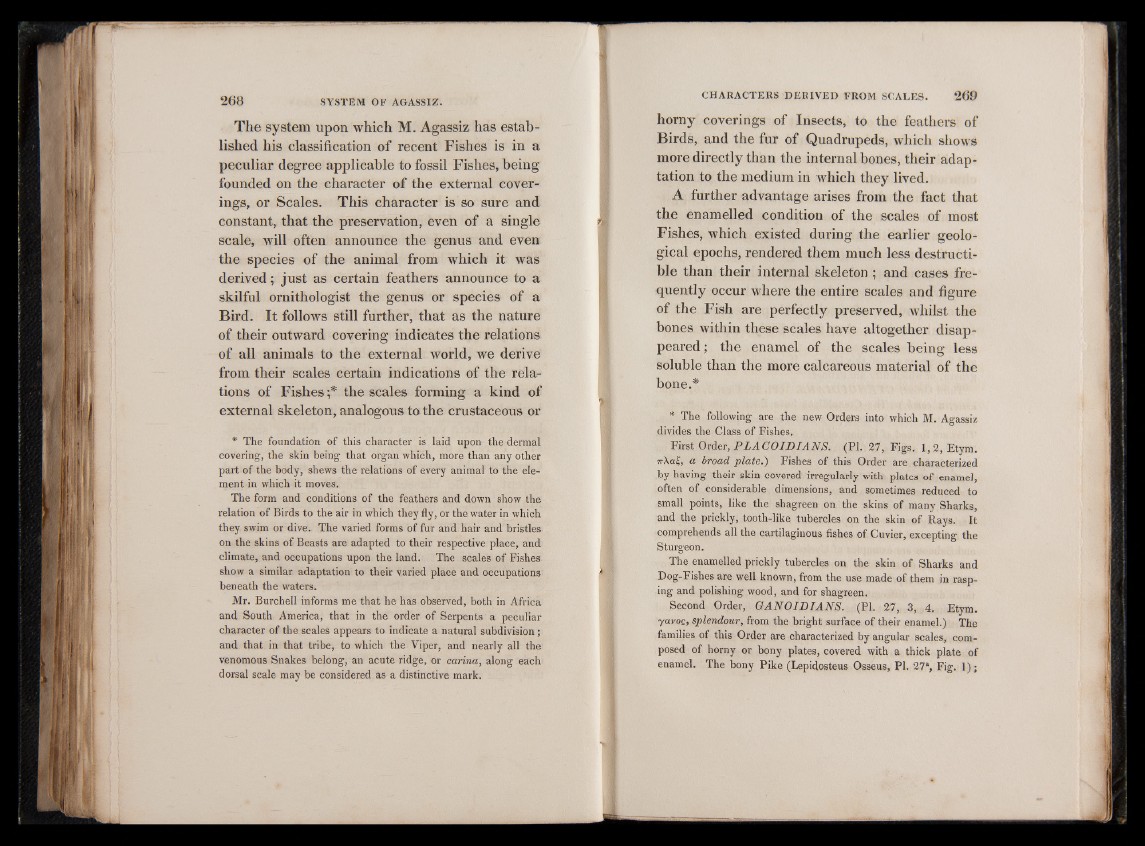
The system upon which M. Agassiz has established
his classification of recent Fishes is in a
peculiar degree applicable to fossil Fishes, being
founded on the character of the external coverings,
or Scales. This character is so sure and
constant, that the preservation, even of a single
scale, will often announce the genus and even
the species of the animal from which it was
derived; just as certain feathers announce to a
skilful ornithologist the genus or species of a
Bird. It follows still further, that as the nature
of their outward covering indicates the relations
of all animals to the external world, we derive
from their scales certain indications of the relations
of Fishes ;* the scales forming a kind of
external skeleton, analogous to the crustaceous or
* The foundation of this character is laid upon the dermal
covering, the skin being that organ which, more than any other
part of the body, shews the relations of every animal to the element
in which it moves.
The form and conditions of the feathers and down show the
relation of Birds to the air in which they fly, or the water in which
they swim or dive. The varied forms of fur and hair and bristles
on the skins of Beasts are adapted to their respective place, and
climate, and occupations upon the land. The scales of Fishes
show a similar adaptation to their varied place and occupations
beneath the waters.
Mr. Burchell informs me that he has observed, both in Africa
and South America, that in the order of Serpents a peculiar
character of the scales appears to indicate a natural subdivision;
and that in that tribe, to which the Viper, and nearly all the
venomous Snakes belong, an acute ridge, or carina, along each
dorsal scale may be considered as a distinctive mark.
horny coverings of Insects, to the feathers of
Birds, and the fur of Quadrupeds, which shows
more directly than the internal bones, their adaptation
to the medium in which they lived.
A further advantage arises from the fact that
the enamelled condition of the scales of most
Fishes, which existed during the earlier geological
epochs, rendered them much less destructible
than their internal skeleton ; and cases frequently
occur where the entire scales and figure
of the Fish are perfectly preserved, whilst the
bones within these scales have altogether disappeared
; the enamel of the scales being less
soluble than the more calcareous material of the
bone.*
* The following are the new Orders into which M. Agassiz
divides the Class of Fishes.
First Order, PLACOIDIANS. (PI. 27, Figs. 1 ,2 , Etym.
7rXa£, a broad plate.) Fishes of this Order are characterized
by having their skin covered irregularly with plates of enamel,
often of considerable dimensions, and sometimes reduced to
small points, like the shagreen on the skins of many Sharks,
and the prickly, tooth-like tubercles on the skin of Rays. It
comprehends all the cartilaginous fishes of Cuvier, excepting the
Sturgeon.
The enamelled prickly tubercles on the skin of Sharks and
Dog-Fishes are well known, from the use made of them in rasping
and polishing wood, and for shagreen.
Second Order, GANOIDIANS. (PI. 27, 3, 4. Etym.
yavoQ, splendour, from the bright surface of their enamel.) The
families of this Order are characterized by angular scales, composed
of horny or bony plates, covered with a thick plate of
enamel. The bony Pike (Lepidosteus Osseus, PI. 27% Fig. 1);